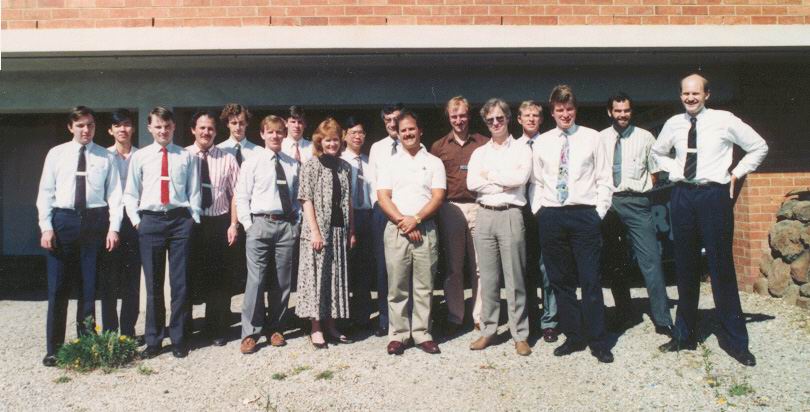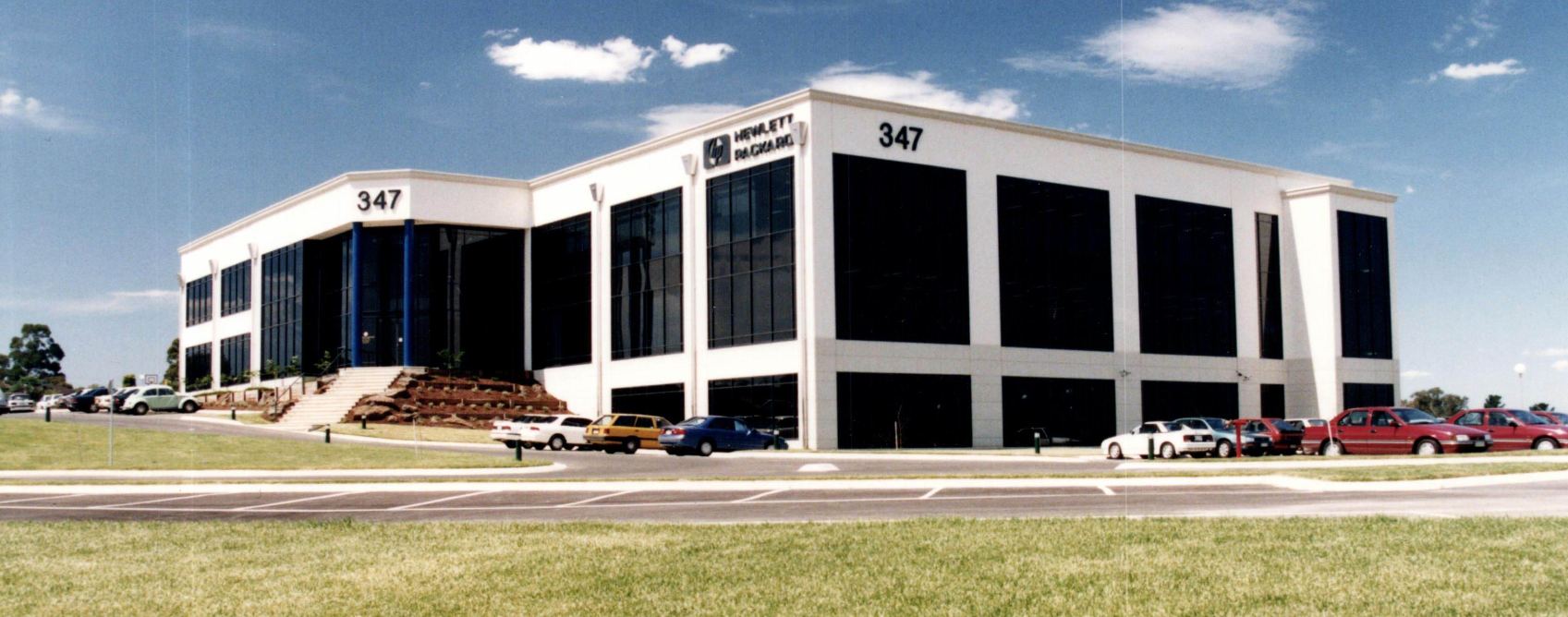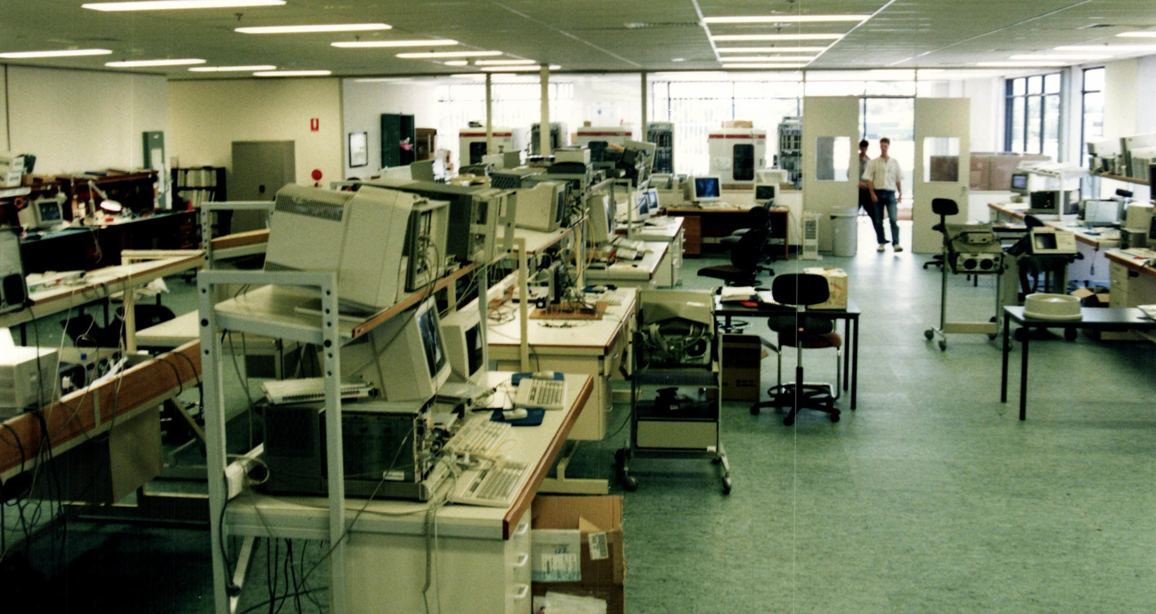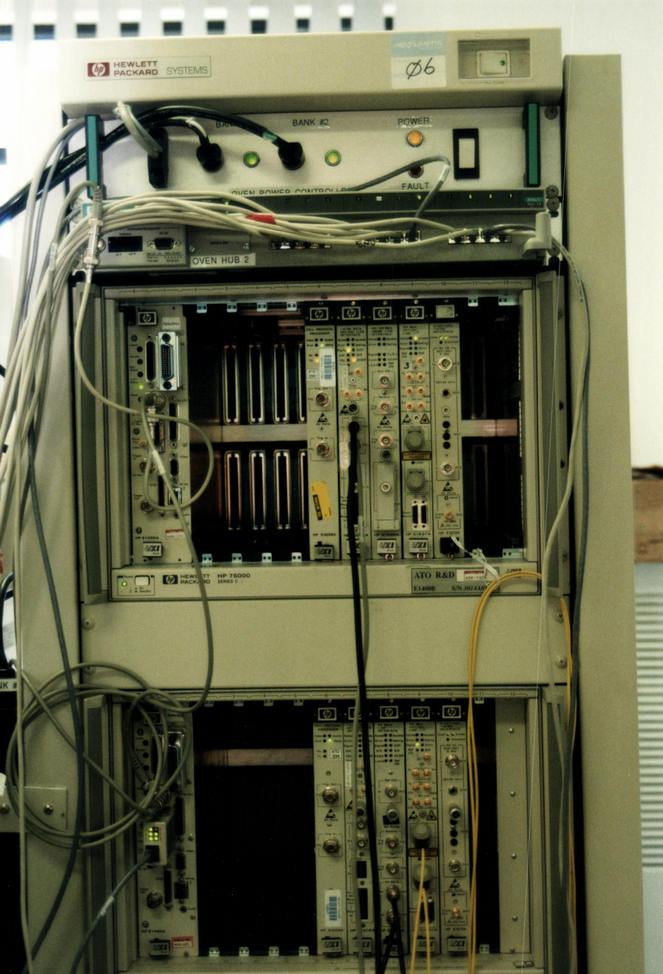Advanced Networks Division
The most significant local initiative ever undertaken by HP in Australia was The Advanced Networks Division. The Advanced Networks Division was born out of a project conducted for Telecom Australia (now Telstra). In the early days of HP Australia, the company was required to offset imports through local value-added activities. This provided significant incentive for the company to conduct various activities, including the Australian Software Operation.
In 1987, HP Australia won a Telecom Australia tender to provide a system to monitor microwave-radio based telecommunications network traffic. The contract required a significant number of small computer systems, along with some custom software and instrumentation hardware. The Digital Performance Monitoring System project was thus established under HPís corporate development arm, managed by Bruce Graham. A small team was assembled, with the outsourcing of software and hardware components to two local development firms, TUSC Computer Systems and IO Design. HP took overall responsibility for the coordination of the development activities and systems delivery.
 |
 |
|
|
The original ATO team in Blackburn |
AND's purpose built home in Forest Hill, Victoria. |
As the development of the instrumentation proceeded, assistance was sought from the Queensferry Telecom Division of HP, located in Edinburgh, Scotland. The project was highly successful, with several requests coming from other telecom operating companies around the world who had similar needs and had learned of the existence of the systems through Telecom Australia. HP Australia, seeing the potential technology export possibilities, agitated for an expansion of the fledgling activities in Australia. The leadership and support from the HP Australia and Palo Alto-based Intercontinental Operations management team was critical to achieving this. Along with Bruce Graham, Malcolm Kerr (the HP Australia MD at the time), and Bruce Thompson enlisted the support of Alan Bickell (Intercon VP) and Lee Ting (Intercon Corporate Development Manager). This culminated in the Microwave and Communications Group General Manager, Dick Anderson, granting permission in April 1989 for the establishment of a ďlicenseeĒ relationship under the Queensferry Telecom Division. The team, led by General Manager Bill Wood, was formalized as the Australian Telecom Operation (ATO), and began a formal reporting relationship into the test and measurement organization of Hewlett-Packard Company.
The team was expanded with the recruitment of several additional engineering and marketing staff, and began market development activities in Europe. Despite the market potential and interest from potential customers in Europe, a perceived market conflict with an existing HP European relationship lead to redirection of the team into an adjunct area. While this was initially a major blow to the small team, it turned out to be fortuitous indeed.
In the early 1990ís new telecommunications technology was being born in the labs of several major global telecom equipment manufacturers. Driven by the need to transport a rapidly accelerating amount of digital traffic, a new standard took advantage of advances in optical fiber technology to carry significantly larger amounts of digital traffic.
The ATO had recruited among others R&D engineers from the R&D arm of Northern Telecom (Nortel), the Canadian telecom equipment manufacturer. With the insight brought, the ATO team began development of a sophisticated simulation and analysis system targeted at the design and manufacture of the so-called synchronous optical network systems. Within a short period of time the team had an accelerating demand for these high value systems, and a significant export business began. The Operationís SONET/SDH Analyzer was launched in 1990/91 and became a major market success for HP, opening a new market for the company. The efficiencies gained through the use of the system by design and manufacturing teams meant that telecom equipment companies were prepared to pay quite a premium for such systems, leading to a high margin export business for HP Australia.
The 1990ís were a boom time in the telecommunications. Rapidly growing traffic driven by the emerging Internet and pervasive mobile networks was driving an insatiable demand for bandwidth. Throughout the 90ís the Australian team built on market success with new products targeted at adjunct markets, including Asynchronous Transport Mode systems and subsequently TCP/IP (the language of the Internet). Such was the success of the product lines that in November 1997 the operation became a division in its own right Ė the Advanced Networks Division, reporting directly into the group level of the company, headed by Chuck Acken, a steadfast supporter of the team. The growth of the activities of the Australian team lead to the construction and completion in of a new purpose-built and dedicated facility in East Burwood, Victoria. Opened in March 1996, by the State Premier Jeff Kennett, the facility housed R&D, manufacturing, sales, marketing and finance for almost 200 staff members at that time.
 |
 |
|
|
The R&D lab at AND. |
ATM analyzer system testing. |
The division contributed over A$150 million in revenues to HP Australia in 1998 alone, with export value in excess of US$90 million. During the 1990ís the division exported well over of a quarter billion dollars of cutting edge technology to the world. The division itself became a global one, leading to the acquisition of two companies in the United States, and encompassed satellite R&D teams in New Hampshire, Massachusetts, Vancouver Canada, Edinburgh Scotland and later setting up a new team in Bangalore India. The R&D team in Vancouver, previously Edmonton Alberta, contributed substantial core technology to the highly successful Broadband Series Test System (ATM). With the spin off of Hewlett-Packardís test and measurement, semiconductor, medical product and chemical analysis businesses into Agilent Technologies, the Advanced Networks Division became a focal point for and provider of infrastructure for Agilent in Australia.
The boom years for the telecommunications industry globally throughout the late 80ís and 1990ís came to an abrupt halt in 2001. While the business had benefited from the rapid growth of the global telecommunications industry, it also suffered from the momentous downturn which continued into 2002 and 2003. The substantial consolidation of Agilentís test and measurement business lead to significant reductions in staff numbers as well as worldwide consolidation of manufacturing and administrative activities.
In spite of the downturn, Agilentís Advanced Networks Division was able to continue innovating. 1999 saw the introduction of RouterTester, the first product to focus on testing performance and scale of the emerging IP based internet. Traction for this product was exceptional with leading networking companies including Cisco, Juniper, Lucent, AT&T, NTT, and others. The team in Melbourne had transitioned the business from SONET/SDH and ATM to being focused on core IP networking, MPLS, and other packet-based technologies. Throughout the next decade RouterTester and its N2X modular hardware platform generated more than $US500M of business for Agilent with the Melbourne team leading most of the development across Melbourne, India and Vancouver sites.
Over two decades this Burwood based team generated many industry firsts in high-speed core networking, including first to market for 155Mb/s, 622Mb/s, 2.4Gb/s, 10Gb/s, 40Gb/s transport as well as important core networking protocols such as Routing, MPLS, GMPLS, Optical Networking and others. Much of todayís high speed internet infrastructure was designed and tested by RouterTester N2X.
By 2009 the market for core networking had become very competitive and was ripe for consolidation. Agilent decided to exit and sell the RouterTester N2X business to Ixia (for $44M), a competitor based in California. This became one of the most successful acquisitions for Ixia helping to propel revenues from a flat $180M to a >25% growth rate for the next 5 years. The R&D activities continued in East Burwood until end of 2012 when the site was officially closed.
Much of the intellectual property and breakthroughs that AND had created continue to live on as part of the Ixia portfolio. More importantly, many of the engineers who flowed through the R&D facility gained valuable experience and moved on to further their careers at other local and international companies in various fields of technology.
| Back |
^ TOP©2004 - 2024 BGImages Australia - All Rights Reserved.
The HP Computer Museum and BGImages Australia are not affiliated with HP Inc. or with Hewlett Packard Enterprise. Hewlett Packard and the HP logo are trademarks of HP Inc and Hewlett Packard Enterprise. This website is intended solely for research and education purposes.
